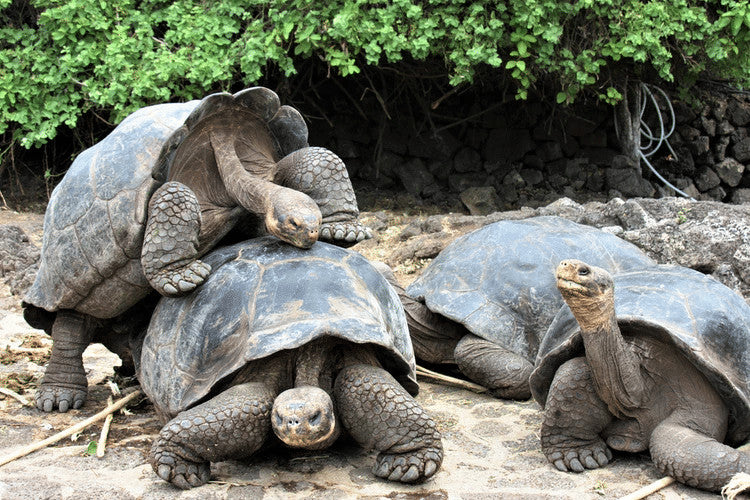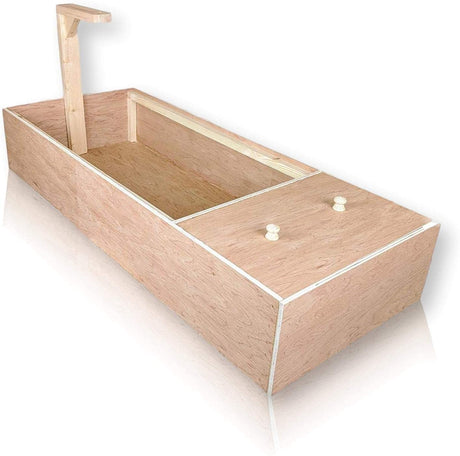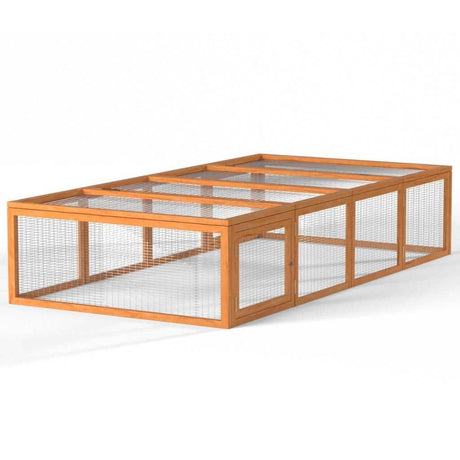Things to Consider...
Before we get into the details, there are a few things that need to be taken into consideration.
Time of Year
Most tortoises will begin the process of courtship and mating after hibernation, in early spring. It is common to see these behaviours all the way through summer, too.
However, the mating season can vary depending on where they are found in the wild and the kind of conditions they prefer. For example, sulcata tortoises can be spotted copulating any time between June and March but it is most common after the rainy season in September. Meanwhile, red-footed tortoises will mate at any time of the year however prefer to lay their eggs from June to September.
If your tortoise hibernates, they're likely to go looking for a mate when they awaken in spring, so this will be a good time to separate them if you have both male and female tortoises. Either way, always look out for behaviours that may suggest they are getting ready to copulate, as you don't want to be caught unawares with a clutch of eggs!
Finding the Right Match
Just like humans, and other creatures within the animal kingdom, not all tortoises will want to mate with each other. What's more, you can't just put two tortoises together and expect their offspring to be healthy, either!

If you are hoping to breed your tortoises, you need to do your research and make sure that you are not unknowingly inbreeding them. If you breed two tortoises that are closely related, they are unlikely to produce viable offspring; the hatchlings are more likely to have deformities or will not develop or hatch at all.
It is also important that the tortoises are of the same species and the same subspecies; even the eastern and western red-footed tortoises would not be suitable matches for each other. If two different species were to mate, it is unlikely that the female will lay fertile eggs and therefore they would not produce any hatchlings at all. What's more, it could also cause problems with the development of the eggs which, in turn, can be dangerous for the female.
Finally, both breeding tortoises need to be healthy to be able to produce healthy offspring, too. The stress of laying eggs can often be detrimental to the health of older females so it's better to select younger tortoises, where possible.
What Age Can Tortoises Breed?
The age at which tortoises reach sexual maturity is dependent on the size of their shell therefore it ranges depending on where they live. Captive tortoises often grow quicker due to having constant access to food so it is common for them to be sexually mature as early as 4 years of age. However, those in the wild grow at a much slower pace so may not be ready to mate until they are 20 years of age.
With that said, it is recommended that you do not let your tortoises mate when they are too young as it could affect their growth and development.
The Perfect Environment
If the female tortoise does not have an ideal environment then she may retain her eggs which can have serious complications. There needs to be sufficient warmth and UVB radiation as well as an abundance of food.
If the male tortoise is too aggressive then it could actually do more damage than good and the female may not want to mate with him at all.
Furthermore, if they do copulate successfully when the female starts to show signs that she is ready to lay her eggs, it's important that she has a stress-free environment, which may involve removing the male if he begins to bother her.
How do Tortoises Mate?
As you may have begun to realise, there is more to tortoise breeding than you had originally thought. Once they have found the right match and the conditions are perfect, you may start to see the following processes take place...
Courtship
Although the courtship techniques will vary between species, there is one thing that they have n common - aggression. Male tortoises will bite at the females, ram into them with their shells, and the male circles around them in an intimidating manner. Some other behaviours you may see in specific species as courtship begins may include:
- Radiated tortoises: you may see males lifting up the shells of the female tortoises so that they cannot move away. You'll also likely see lots of sniffing and head bobbing, too.
- Leopard tortoises are known to be especially aggressive, with males ramming the females repeatedly, sometimes even lifting them off of the ground.
- Star tortoises are a little more subdued with very little aggression towards each other
- Red-footed tortoises are very vocal during the mating season and will produce clucking noises to both attract mates as well as ward off any other males.
Males tend to prefer larger females, therefore if you have two females in an enclosure with one other male, it is better if the females are of a similar size so that the male doesn't give too much attention to just one female.
Mating
After some persistent advances from the male, the female tortoise will often submit and retract into her shell; this is the cue for the male to begin mating.
The male tortoise will stand sturdy on his hind feet and place his front legs on the back of the female's shell, this is made easier by the fact that the underneath of the male shell is slightly more concave than that of the females. However, you may notice him readjusting his back legs to ensure that his tail aligns with that of the females.
Once in position, the male vigorously stamps his feet whilst releasing a stream of grunts and hisses until he has finished, making it quite a noisy affair.
The male will usually copulate with a female several times before letting her go.

Aggressive Males
It is also worth noting that males are increasingly aggressive towards each other during this time. If you have two males sharing an enclosure with a female they can cause each other serious injury while trying to show dominance and ward off his competition.
Displays of dominance include:
- Biting
- Ramming of the shells
- Head bobbing
- Attempts to flip the competition onto their back
- Standing tall
- Stretching their neck
Dominant males mate more frequently than less aggressive males therefore it pays to be brutal!
Gestation
One of the most important things to know if breeding your tortoises is knowing how to tell if your female is carrying eggs, otherwise known as gravid, and when they are ready to lay their eggs. During this period you should give your female additional calcium supplements several times a week.
The easiest way to know for sure if your female is carrying eggs or not is to take her to the vet for an x-ray. However, here are some behavioural cues you can also look out for:
Change in Appetite
Although a loss of appetite can be a sign of several things in tortoises, if your female tortoise has recently successfully mated and has gone off her food, it could mean that she is carrying eggs. As you can probably imagine, all of those eggs take up a lot of room inside of a tortoise therefore it suppresses the appetite.
Behavioural Changes
Any changes in behaviour are worth noting. Some females will hide away in their shelters while others will become very restless and will be constantly on the move, pacing up and down their enclosure. This exploratory behaviour can include digging and climbing which can get them into some dangerous situations if you aren't careful!
Monitor your tortoise for any changes in behaviour as it could be a sign they are getting ready to nest.
Aggression
Females may show aggression towards other females and may even try to mount them in an act of dominance. This is likely a way to try and secure the best nesting site.

Testing the Soil
The temperature and consistency of the soil need to be just right for a female to want to lay their eggs in it therefore you may notice them scratching at the soil with their front legs. Some species will even eat some of the soil to test its suitability for nesting.
Egg Laying
Now on to the actual process of laying the eggs!
Gestation Period
Female tortoises can store sperm for up to four years therefore after your tortoises have copulated, there is really no telling when your tortoise will lay her eggs. In the wild, egg-laying often takes place in the spring or summertime when it is warm and conditions are optimum, however, there is no specific time frame and they can, realistically, lay their eggs all year round.
In captivity, it is even harder to guess when they will lay their eggs as the conditions remain constant.
For greater reproductive success, females will sometimes have two clutches of eggs. Due to their reproductive anatomy, they can separate the fertile eggs into two clutches, only allowing one clutch to develop at a time.
Looking for a Nest Site
Tortoises look for very specific conditions to lay eggs, a wild tortoise will usually opt for a slope to ensure that their nest will not flood and become waterlogged. They need a place that receives sunshine all day so the temperature remains stable and the hatchlings can develop.
The soil needs to be the right consistency so that it will not collapse on the eggs but also so that it is not too firm that the hatchlings will not be able to climb out when they're ready, or that it takes the female too much energy to dig it out.
If they cannot find an ideal nesting site, they will retain their eggs which can cause complications. Similarly to other egg-laying reptiles, the tortoise can become egg bound it can be fatal if not addressed with the correct measures; a dose of oxytocin from the vets can encourage a tortoise to lay its eggs if it's caught early enough, however, there is no guarantee these eggs will be viable.
Building the Nest
If successful in finding the right conditions, a tortoise will proceed to build a nest and is commonly done in the afternoon or early evening. The female will clear the area with her front legs and then dig out the soil with her rear legs using circular motions to create two piles of soil on either side.
The tortoise will only finish when it has reached the right depth which is usually about three-quarters of the length of her shell, or when one of her fully outstretch rear legs can no longer reach the bottom.
Laying the Eggs
When the nest has been dug the gravid female will position her hind legs on either side of the hole and begin laying her eggs one by one. Tortoise eggs are white and spherical in shape, with the size differing depending on the species of the tortoise.
As she lay each egg, she takes the time to roll them to each side of the nest to make sure the next egg doesn't land directly on top of another. This, in turn, prevents any possibility of cracking, and it also coats each egg in a thin layer of soil that further protects them and prevents them from sticking together. This whole process can take several hours from start to finish.
Once all of the eggs have been laid the female will usually take a little break before covering the nest again, smoothing it over, and making it look as if nothing ever happened. From this point on, most females will have no contact with the nest, and neither males or females offer any parental care to the hatchlings hereafter.
Incubation
The incubation period changes depending on the species of the tortoise:
- Radiated tortoise - 145-231 days
- Sulcata tortoise - 243 days
- Red-footed tortoise - 117-158 days
- Hermann's tortoise - 90 days
- Star tortoise - 47-180 days
- Greek tortoise - 65-75 days
- Russian tortoise - 60-75 days
Tortoise eggs have to stay at a certain temperature to be able to develop. What's more, as with other reptiles, the temperature inside the nest also affects the sex ratio of the hatchlings. This means that if the temperature is too high, more females will develop, and if the temperature is too low, more males will develop.
If the temperature goes above or below the desired range, then it can be disastrous for the clutch of eggs and can drastically reduce their survival rate.
In the wild, the natural sunlight and the moisture from the earth are enough to keep the nest at an optimum temperature, however, in captivity, they often require an incubator or an additional heat source to ensure the nest remains stable.
Hatching
As the baby tortoises reach the end of the development within their eggs, they begin to stretch out, causing their beaks to force their way through the eggshell. Their beaks have something called an egg tooth that is a bony protrusion and aids the tortoise's escape from their egg.
When the shell has been broken, the tortoise will use their legs to make their way out of their egg and out of the nest. Unlike sea turtles, tortoises will not all leave the nest at the same time, with up to 3 weeks between the first hatchling emerging and the last.

Pet tortoises have a much better chance of survival than the wild populations however hatchlings can still face many problems when leaving the nest, wherever they are. If the eggshell is too hard or the soil is too wet, they can struggle and die. Make sure that you monitor them and offer encouragement if they need it.
Final Thoughts
So that's all you need to know about tortoise mating, hatching, and how to make sure your tortoises remain healthy throughout the whole process.
It is always important to monitor your pets, but even more so when you have a male and female interacting with each other. Although a beautiful process, a lot can go wrong and so it is important to make any decisions with your tortoises best interests at heart. If you don't think you can provide the correct conditions for your female to lay, as well as for the eggs to develop, it's best to leave it to those who can.
Let us know if you breed your tortoises and any experiences you have had!





6 comments
I have a female desert turtle nd am looking for a male to mte her with in Las Cruces New Mexico. call at 575-805-0149 if you have a male at a reasonable cast or email mea at doylepruitt99@gmail.com.
I have a female tortoises and I live in Kirksville MO I would to breed her. If there is anyone in or close to me please let me know you can text me or call me at 16602161952 and leave a message I will be grateful appreciated for any help given. Ruth
Just want to say thanks for the help l asked for never received goodbye……
I have a male Russian tortoise about 8/10 yrs had him 9mos now noticing he’s in heat needs to mate don’t know what to do or where to bring him for mating he’s rubbing against a store & making a little sound…if anybody can help me please get in touch my nancy live in RI my # 4016968985 thank you
Hi Rosie! Thank you for writing this article. It was amazing! I learned so much!!! I’m hoping to have hatchlings soon!!!
How do tortoises grow? I want to know